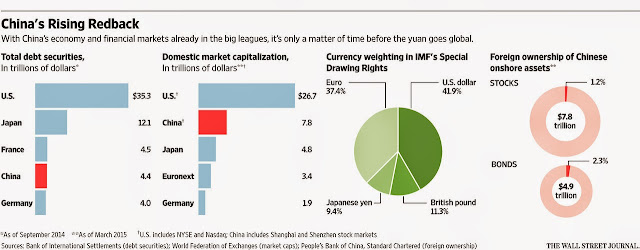Here Comes the Yuan
Demand for the Chinese currency is set to rise in years to come, which will have long-term impacts
By Wei Gu
May 21, 2015 7:32 a.m. ET
To enlarge graph click here
Investors and economists may follow every twist and turn of China’s financial overhaul, but Beijing takes the long view. In time, the country’s markets and economy will open up.
So the question isn’t whether the yuan will be included this year in the International Monetary Fund’s Special Drawing Rights—a collection of global currencies that forms a special reserve asset—or when exactly the Chinese stock market will join major global indexes. These things are coming. The question is what the long-term impacts will be as investors pour money into China, increasing demand for the Chinese currency for years to come.
Currently, the investment world massively underweights yuan assets. The world’s central banks and sovereign-wealth funds have invested an estimated $70 billion to $120 billion in renminbi-denominated assets, according to Standard Chartered —just 0.6% to 1% of world reserves. Foreigners own 1.2% of China’s stock market and 2.3% of its bond market, according to the People’s Bank of China.
Those are tiny shares, given the size of China’s economy and its capital markets. China is the world’s second-largest economy, accounting for 12% of the world’s economic output. Its onshore bond market is the fourth-largest in the world after those of the U.S., Japan and France. China’s stock-market capitalization accounts for 12% of the world’s total, according to World Federation of Exchanges, trailing only that of the U.S.
Foreign net purchases of China’s bonds and equities this year should reach 500 billion to 700 billion yuan (about $80 billion to $110 billion), according to Standard Chartered. The yuan’s inclusion in the IMF’s Special Drawing Rights, whenever that occurs, won’t force foreigners to buy Chinese assets—but it will confer a sort of blessing of the currency, and so encourage investors to raise their exposure.
If inclusion comes this year, cumulative foreign net purchases of China’s bonds and equities could reach 5.5 trillion to 6.2 trillion yuan by 2020, Standard Chartered analysts forecast. Even if inclusion were deferred to 2020, purchases could still reach 3.9 trillion to 4.5 trillion yuan in the next five years. Either way, the trend these analysts see is clear: Within four years, foreigners’ holdings of yuan bonds will exceed their current holdings of bonds in any other single emerging market. Standard Chartered expects a persistent rise in global diversification into yuan assets over the next decade.
The incentives are there for fund managers. First, China’s three-year treasurys yield around 3.5%, versus 1% for their U.S. counterparts and negative yields for those from Switzerland.
China’s low government debt means the quality of its sovereign credit is actually higher than that of many countries, including the U.S. Investors could also be drawn to China’s roaring stock market, which has doubled in a year—gains that non-Chinese investors have largely missed.
Second, China’s capital markets are more liquid now, making them more attractive than those of other emerging economies. Bond trading has grown rapidly, with volume reaching $57 trillion in 2014. The Shanghai-Hong Kong Stock Connect is making it easier for foreign investors to buy Chinese shares. At an estimated $40.5 billion, daily spot turnover for onshore and offshore yuan is still much lower than for the major global currencies, but the bid-offer spread is comparable, according to Standard Chartered.
Smaller emerging economies are likely to be losers as global investors put more cash into China. The net $44 billion increase in foreign holdings of Chinese onshore bonds in 2014 alone is equal to 24% of the total local-currency bond market in Indonesia and 40% of the market in the Philippines. The Chinese government’s low debt gives it more room to issue bonds for foreigners to buy.
All of this assumes that China’s leaders successfully overhaul the economy and keep growth strong.
It’s no certainty. Already cash is flowing rapidly out of the country. The long-term inflows should more than offset those outflows, but financial or political instability could change that.
Buying Beijing ducks in their namesake city; China’s currency is looking to go global. Photo: Tomohiro Ohsumi/Bloomberg News
What is clearer is that the yuan, which is strictly controlled by China’s central bank, is unlikely to rise strongly even if foreign cash flows in. The IMF sees the yuan as close to fairly valued, and the Bank for International Settlements calls the yuan the most overvalued of the world’s major currencies, because of China’s shrinking trade surplus.
For now, Beijing appears to want a stable currency. Given the economic slowdown, letting the yuan appreciate would make Chinese exports more expensive, a bad move during an economic slowdown. Driving the yuan down could help the economy but would cause howls of protest from China’s trading partners.
But that’s in the short term. Over time, there’s little doubt that lots of foreign cash will flow into Chinese financial assets. The impact on China and the rest of the world will be significant.

0 comments:
Publicar un comentario